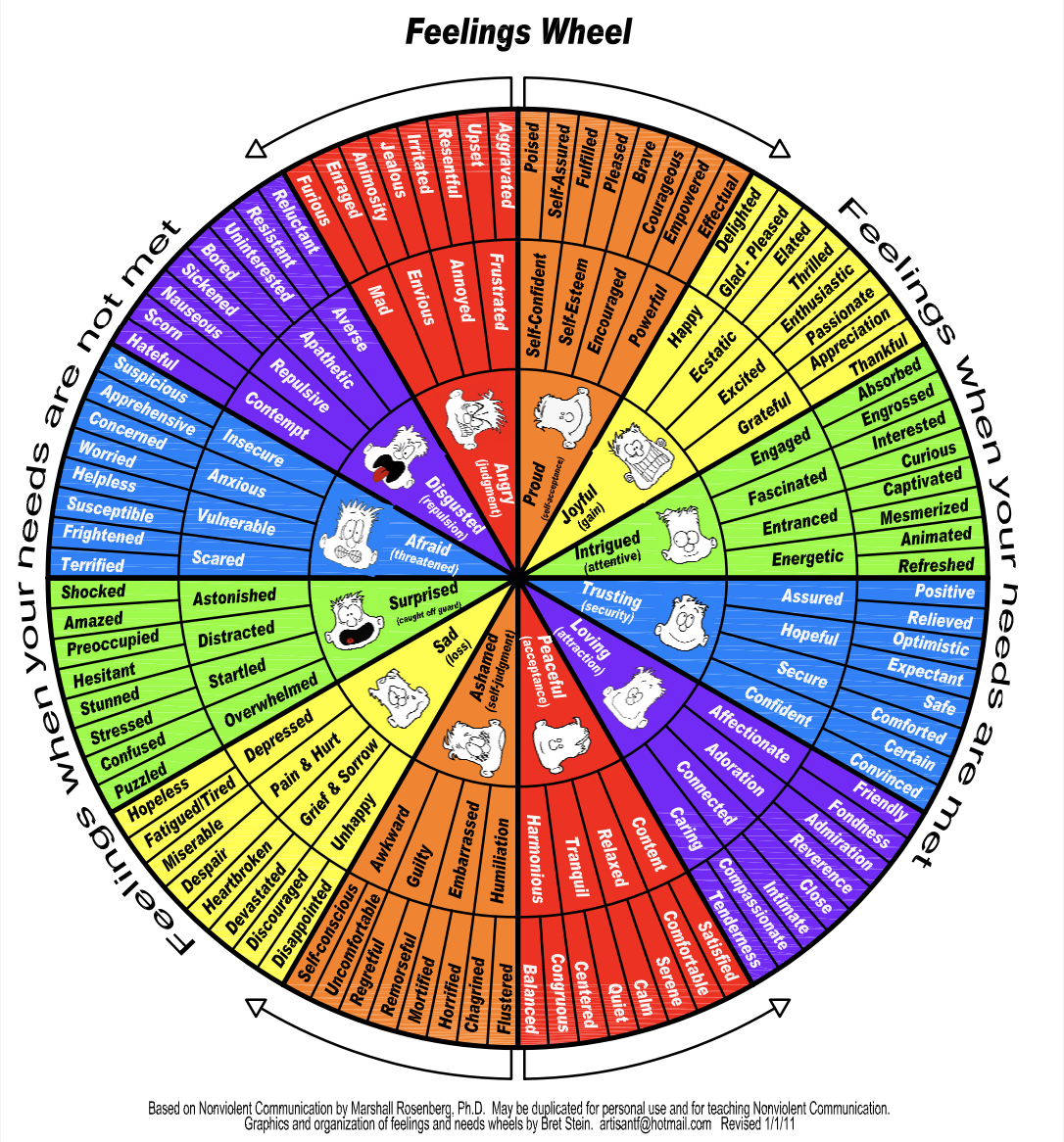Printer-Friendly PDF – Ten steps to improve your Emotional Self-Awareness using the Emotions and Feelings Wheel by Dr Ken McGill
Use the Feelings Wheel along with the questions on the opposite side of this sheet to help you think about your emotions, feelings, thoughts, needs and how they impact you and your relationships – Dr. Ken McGill

The Ten steps to improve your Emotional Self-Awareness
- Your Primary Emotions are in the center of the Wheel. What primary emotion(s) are you currently experiencing?
- Your Primary Emotions may trigger Secondary Feelings. Your secondary feelings are in the Middle and Outer part of the Wheel. Is there a secondary feeling you’re experiencing? What feelings are you identifying?
- Your Secondary Feelings are primarily based on the Thoughts you tell yourself about your situation at hand or the people involved. What thoughts are you telling yourself that are triggering your secondary feelings?
- Considering the emotions, feelings and thoughts you’ve identified, is there a Need you have, or an expectation you’d like to see fulfilled that’s connected to or embedded in the feelings you’re experiencing? What is it?
- What personal responsibility or actions will you take to meet or satisfy your need? What choices do you see yourself making/taking to meet your identified need? How do you think your emotions, feelings and thoughts will be different when you take responsibility to meet your own need(s)?
- Perhaps you need assistance from another person to meet the need you have, that’s connected to your emotions, feelings, or thoughts you’re having. What “reasonable assistance” would you like to present or request from the other person(s)? How do you think your emotions, feelings and thoughts will be different if the other person partners with you to meet your need(s)?
- In 3 – 4 minutes share these 7 things you’ve learned about your emotions, feelings, thoughts, needs, etc.:
- My Emotions: “I have this sinking feeling in my gut; I’m feeling afraid right now.”
- My Feeling: “I’m feeling anxious about what you said and insecure because I may not do this correctly.”
- My Thoughts: “I’m really worried and pressured that you’ll be pissed at me and I’ll never satisfy you.”
- My Need: “I just need you to be patient with me and know that I’m not trying to willfully frustrate you.”
- My Responsibility: “I’ll talk about my fears and concerns sooner versus stuffing and ignoring my feelings.”
- My Request for You to consider: “Will you sit down with me tomorrow so we could plan what we’ll do?”
- Our Outcome: “I’m feeling relieved and hopeful we’re both going to work together on this…I like that!
- Which of the emotions or feelings would you like to experience on the Feelings Wheel? Keep in mind that sharing your thoughts, exercising choices, meeting your needs, choosing to change and working with others to create “win-win” outcomes are powerful determinants when it comes to the feelings you’ll experience!
- What processes (taking deep breaths, requesting a “time-out,” going for a walk, praying, listening to music or sitting quietly, etc.) and what thoughts might you change (challenging automatic negative thoughts, integrating positive affirmations about yourself, using communication tools, etc.) that will help you to move toward, get closer to, or create the feelings and outcomes that are most appealing to you (and your partner)?
- What feelings do you feel the most? Which are more “comfortable” for you to share with others? Which are more difficult for you to share? Which “feeling states” and frames of mind would create a safe environment to keep you and your partner at the “table of communication” to create understanding or resolve problems?
Bonus Question: How does it feel to know you’re “coming to your own assistance” as you do the “Adult work” of identifying the message(s) in your emotions, your feelings, your thoughts, your needs and the fact you’re capable of creating desired outcomes for yourself and your relationships? Will you refer to the Feelings Wheel in the future to sort out your feelings? Will you use/share this tool with your partner, children, co-workers (if appropriate) and others to help them understand their emotions, feelings, thoughts and needs? Thank you!
Thanks for reading this excerpt from Cultivating Love: Wisdom for Life. As time permits, please visit the other blogs written by Dr. Ken McGill: Daily Bread for Life and “3 – 2 – 5 – 4 – 24″ for additional information that could be helpful.
I welcome your comments below or via email and your favorites, your retweets and your “+1’s” if you have a brief moment and find the information helpful. Again, it is my desire to provide the very best info for your consideration.
TeleHealth/Video counseling sessions are available for those who prefer to meet online – Dr. McGill